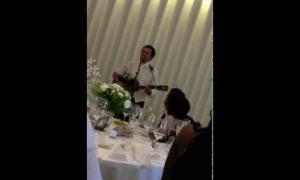Write where you meet
July 15, 2015
In search of speechwriting solitude, I wrote in the rooms where the speech would be delivered. I found much more than quiet.
Where do you do your best speechwriting? In your office with phones bleeping and colleagues dropping by? At home amidst a riot of restless kids and barking beagles? Why not just lug a laptop to your next Metallica concert?
Maybe you’re better at filtering out the clangor of the modern workplace than I am. But the pursuit of silence recently drove me to discover a new approach to speechwriting: place-based writing.
As I told my colleagues at the recent (and terrific) PSA Leadership Communication Days for college and university speechwriters, “I like going places and writing stuff.” So I went places: specifically, to the sites where my principal was scheduled to speak. And I wrote stuff: to wit, his speeches.
It worked. I got the peace and quiet I needed. But I also found something more: my speeches got better, because the rooms helped me write them.
The move was propelled less by inspiration than desperation. As the vice president of a national liberal arts college I’m pulled in a thousand directions every day. Crisis after crisis, initiative upon initiative: to sit down at my desk is to submit to an onslaught of demands for time and attention.
So I sought refuge. Realizing that college presidents often speak in rooms that are largely otherwise unused, I figured I’d hide out and write. The first site I tried was the campus chapel, which is reliably vacant at most schools most of the time. Sitting there on a stern wooden bench, hurting for inspiration (and a cushion), I remembered the plaque in the rear of the room honoring the 11 Grinnell students killed fighting for the Union Army. They constituted almost our entire student body at the time: the loss of so many male students prompted the College to admit women long before it might have done otherwise. Suddenly I had half of a pretty good speech—and the better half, at that.
Inspired, I started making place-based writing a habit. If I couldn’t get to a location in advance I’d at least arrive early on the day of, for a little rewriting in situ.
Plenty of speechwriting handbooks (Bob Lehrman’s Political Speechwriter’s Companion, for one) urge speechwriters to think about venue. We disregard the subtleties of setting at our (and our speaker’s) peril. But I’ve now seen the benefit of going a step further. Drafting or revising a speech on location sharpens my mental image of the occasion: suddenly I’m in tune with everything from acoustics and atmospherics to crowd flow and the all-important intangibles. Will the founders’ portraits look down admiringly on a litany of historical highlights? Could the view through the floor-to-ceiling windows invite a visionary tour d’horizon? The possibilities are as varied as the places.
I don’t think the idea amounts to a flash of brilliance. It was more of a happy stumble over something that in hindsight was patently obvious. Experienced writers recognize that a successful speech requires the right words, spoken by the right person, in the right place, at the right time, to the right audience. Place is an important factor in the equation: writing in a place helps me write for that place.
We’ve all encountered rooms that electrified rote turns of phrase, and others that smothered the most fiery calls to action. The connection between speaker and space is a form of partnership. So why not work with your partner … and get it to work for you?


